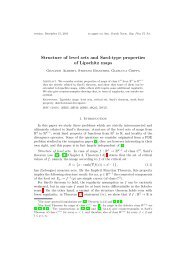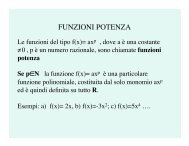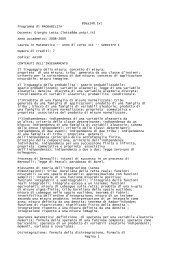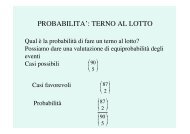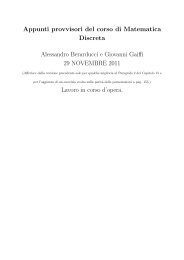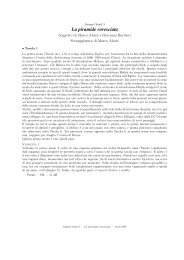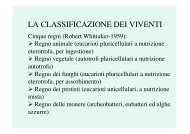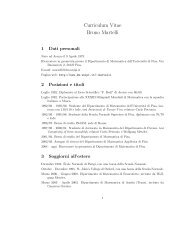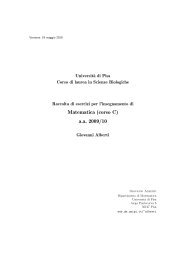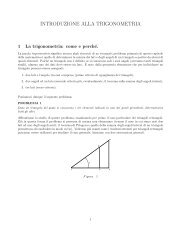Immersioni aperte in dimensione infinita - Dipartimento di Matematica
Immersioni aperte in dimensione infinita - Dipartimento di Matematica
Immersioni aperte in dimensione infinita - Dipartimento di Matematica
Create successful ePaper yourself
Turn your PDF publications into a flip-book with our unique Google optimized e-Paper software.
46 Embedd<strong>in</strong>g aperti <strong>di</strong> varietà <strong>di</strong> <strong><strong>di</strong>mensione</strong> <strong>in</strong>f<strong>in</strong>ita<br />
C t(u) ∩ C t(u ′ ) = ∅, dunque, per costruzione, esiste un As con C t(u) ∪ C t(u ′ ) ⊂ St(C t(u)) ⊂ As.<br />
Ricordando quanto osservato nel punto (ii) <strong>di</strong> cui sopra, segue che x, y ∈ St(Ct(u)) ⊂ As; <strong>in</strong>f<strong>in</strong>e,<br />
<strong>in</strong>vocando il lemma 2.62, la restrizione <strong>di</strong> Tn ad (As ∩ Mn) × rH n (r < d, d|As < dxs ) è un<br />
<strong>di</strong>ffeomorfismo.<br />
In conclusione, riassumendo, abbiamo provato che se (x, v), (y, w) ∈ Mn × rH n sono tali che<br />
Tn(x, v) = Tn(y, w), allora (x, v), (y, w) ∈ (As ∩ Mn) × rH n , cosicché (x, v) = (y, w). Dunque la<br />
restrizione <strong>di</strong> Tn a Mn × r| H Mn n è <strong>in</strong>iettiva, e siccome Tn è un <strong>di</strong>ffeomorfismo locale segue che<br />
Tn| Mn×r|MnH n è un <strong>di</strong>ffeomorfismo con l’immag<strong>in</strong>e:<br />
Mn × r| H Mn n <br />
∼ = Tn Mn × r| H Mn n .<br />
<br />
Chiaramente Tn Mn × r| H Mn n ⊃ Mn, <strong>in</strong>fatti per ogni x ∈ Mn<br />
Tn(x, O) = exp Sn(x, O) <br />
= exp<br />
h µh(x) <br />
−1(O)<br />
d(ϕh)x = exp(Ox) = x.<br />
Inf<strong>in</strong>e, posto per ogni n <strong>in</strong> N<br />
<br />
Un := Tn Mn × r| H Mn n ⊂ M (2.5.9)<br />
si ottiene un sotto<strong>in</strong>sieme aperto <strong>di</strong> M. Proviamo anche questa affermazione con tutti i dettagli. Sia<br />
y <strong>in</strong> Un = Tn(Mn×r|MnH n ). Siccome, ove def<strong>in</strong>ito, Tn è un <strong>di</strong>ffeomorfismo locale, per def<strong>in</strong>izione <strong>di</strong><br />
<strong>di</strong>ffeomorfismo locale esiste un <strong>in</strong>torno Vy ⊂ Un del punto y, Vy aperto <strong>in</strong> M, ed un sotto<strong>in</strong>sieme U<br />
<strong>di</strong> Mn × r|Mn Hn tale che Tn|U : U → Vy sia un <strong>di</strong>ffeomorfismo. In particolare si è così determ<strong>in</strong>ato<br />
per ogni y <strong>in</strong> Un un <strong>in</strong>torno Vy ∋ y aperto <strong>in</strong> M, Vy ⊂ Un. Dunque Un è <strong>in</strong>torno <strong>di</strong> tutti i suoi<br />
punti ed è pertanto un aperto <strong>di</strong> M.<br />
2.5.3 Filtrazioni augmentate<br />
Prima <strong>di</strong> procedere con la <strong>di</strong>mostrazione del teorema pr<strong>in</strong>cipale <strong>di</strong> questa sezione, ci servirà un<br />
ultimo lemma tecnico. Denotiamo con (Um)m≥0 la famiglia <strong>di</strong> <strong>in</strong>torni standard def<strong>in</strong>ita da r/2<br />
<br />
Um := Tm Mm × 1 2r | Mm<br />
H m ,<br />
<strong>in</strong> cui r è la funzione costruita nella proposizione 2.63 precedente.<br />
Lemma 2.64. Ogni punto x <strong>in</strong> M ammette un <strong>in</strong>torno Qx e un <strong>in</strong>tero qx tale che<br />
m > qx =⇒ Qx ⊂ Um. (2.5.10)<br />
Dimostrazione. Come al solito, salvo esplicito avviso contrario, impiegheremo la term<strong>in</strong>ologia e le<br />
notazioni <strong>in</strong>trodotte f<strong>in</strong>o a questo punto. Sia x ∈ M. Esistono 16 dunque <strong>in</strong><strong>di</strong>ci u, s, i ′ tali che<br />
x ∈ Du ⊂ C t(u) ⊂ Bs ⊂ As ⊂ Vi ′ ⊂ W j(i ′ ). (2.5.11)<br />
Supponiamo per assurdo che non esista un tale <strong>in</strong>torno Qx e consideriamo una successione (yi)i <strong>di</strong><br />
punti <strong>di</strong> Du convergente verso x e una successione <strong>di</strong> numeri naturali (mi)i monotona <strong>di</strong>vergente<br />
tale che<br />
(∀ i) yi /∈/∈/∈ Umi := Tmi<br />
<br />
Mmi × 1 2r | H<br />
Mmi<br />
mi ⊃ Mmi , (2.5.12)<br />
16 Giustifichiamo brevemente le <strong>in</strong>clusioni <strong>di</strong> cui <strong>in</strong> (2.5.11): nelle notazioni della proposizione 2.63, (Du)u≥1 è<br />
un ricoprimento <strong>di</strong> M che costituisce un raff<strong>in</strong>amento <strong>di</strong> (Ct)t≥1; <strong>in</strong>oltre, sempre nelle notazioni <strong>in</strong>trodotte nella<br />
proposizione 2.63, (Ct)t≥1 è un raff<strong>in</strong>amento <strong>di</strong> (Bs)s≥1, quest’ultimo essendo un raff<strong>in</strong>amento shrunk <strong>di</strong> (As)s≥1.<br />
D’altra parte (As)s≥1 è un raff<strong>in</strong>amento <strong>di</strong> (Ax)x∈M tale che, per ogni x ∈ M, nelle notazioni <strong>in</strong>trodotte nel<br />
lemma 2.62, Ax è un <strong>in</strong>torno convesso <strong>di</strong> x contenuto <strong>in</strong> un qualche Vi, essendo (Vi)i≥1 un raff<strong>in</strong>amento (fornito dal<br />
lemma 2.55) dell’atlante layer forte (Wj)j≥1 <strong>di</strong> M.<br />
IMMERSIONI APERTE IN DIMENSIONE INFINITA



